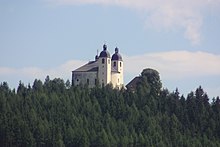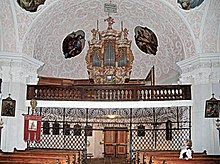Maria Hilf ob Guttaring
The pilgrimage and subsidiary church Maria Hilf in the community of Guttaring is visible from afar at 904 meters above sea level on the hill between the Guttaringer basin and the Görtschitztal . The branch church of the Guttaring parish is one of the few uniform late baroque churches in Carinthia.
history
Around 1640 there was a wooden chapel called Bethfarn on the hill. In 1692 the Guttaringer citizen A. Reiter replaced the original image of grace with a copy of the Passau Maria-Hilf image , over which the Wietingen provost P. Albert Schrenk von Notzing had a brick chapel built. In 1698 the population asked for a chaplaincy to be set up because of the large number of pilgrims. The current church was built from 1725 and consecrated in 1727. In the middle of the 19th century Maria Hilf was raised to the position of Expositur .
Building
The church is a spacious central building with a double tower facade. The building stands on an elongated four-pass floor plan with a square casing. The deeper conches of the east-west axis protrude further beyond the casing, which means that the unadorned west facade between the towers is convexly curved. The towers are crowned by bell-shaped helmets. A lantern with a weather vane in the shape of the Archangel Michael slaying a dragon rises above the octagonal tent dome roof . In the north, east and south conche there are two oratorios each. The vault is decorated with rich bandwork stucco from the construction period and medallions with frescoes by Georg Raf. The birth of Christ and the fall of the bridge of St. John Nepomuk are depicted in the lateral cones . In the western conche you can see St. Joseph and the apostle Simon , in the trombones and in the dome you can see evangelists and apostles , in the lantern the Holy Trinity .
Fresco of Mark the Evangelist
Facility
The high altar, built around 1727, is a large canopy altar with a miraculous image. The painting is a copy of the Innsbruck Madonna by Lucas Cranach . The carved figures on the side symbolize the Christian virtues of faith and hope. In the excerpt, the figure of God the Father is flanked by angels. The crowning of the altar is a crown composed of four volutes with a final Marian monogram in the halo. The carved antependium shows the legend of the image of grace.
The side altars are attributed to Johann Pacher . The founder of the left Anna Altar is probably Wolfgang Eggarter. The chronogram on the predella is newly misspelled and results in the year 1645 instead of 1745. Georg Raf painted the picture of St. Anne with St. Mary. The side statuettes of St. Joseph on the left and Joachim on the right were made by Johann Pacher.
According to the chronogram, the right side altar was created in 1744 and donated by Wolfgang Eggarter. The main picture shows St. John Nepomuk, the sculptures on the side probably depict John of the Cross and Franz Xavier . The painter and sculptor were the same as on the left side altar.
The pulpit from 1767 bears the carved figures of the church fathers on the basket and a fully plastic representation of the Annunciation on the sound cover . The pulpit is also attributed to Johann Pacher.
The first copy of the Maria-Hilf picture from 1692 hangs at the entrance to the bell-room; it was probably attached to the main altar until the new miraculous picture was made in 1746. The 14 Stations of the Cross from the beginning of the 19th century are complemented by a 15th picture depicting the discovery of the Christ Cross by St. Helena . The organ was built by Martin Jäger in 1741. The church chairs were made in 1744.
Other furnishings include a picture of the apostle of St. Paul painted around 1744 on the south-eastern pillar, an oil painting of Maria Immaculata from the second half of the 19th century in the vestibule and votive pictures with Mannsberg Castle from the 18th century, with the fire of Althofen ( 1743) and the fire in Drasendorf (1743).
Service times
Services are currently (2017) celebrated between Easter Monday and the last Sunday in October. The traditional highlights are Whit Monday and the Assumption of Mary .
literature
- August Ebner: Maria Hilf ob Guttaring , Carinthia Verlag, 1976, ISBN 3-85378-019-9
- Alfons Haffner: The pilgrimage church Maria Hilf ob Guttaring and its old votive pictures , Carinthia Verlag, Klagenfurt 2004
- Dehio manual . The art monuments of Austria. Carinthia . Anton Schroll, Vienna 2001, ISBN 3-7031-0712-X , p. 502 f.
- Siegfried Hartwagner: Austrian Art Monograph Volume VIII: Carinthia. The St. Veit an der Glan district . Verlag St. Peter, Salzburg 1977, ISBN 3-900173-22-2 , p. 146 ff.
Web links
Coordinates: 46 ° 52 ′ 52.1 ″ N , 14 ° 32 ′ 4.2 ″ E








